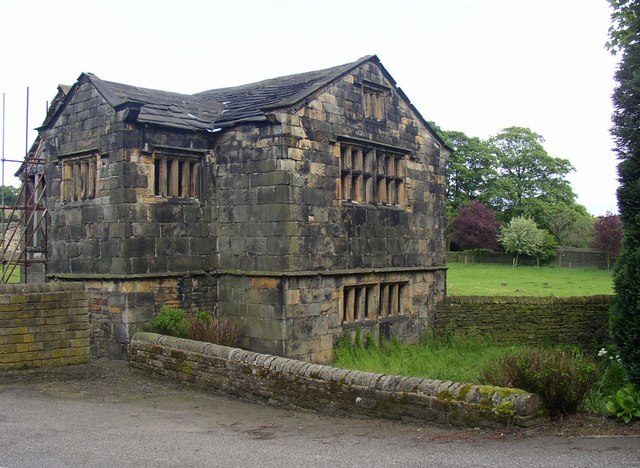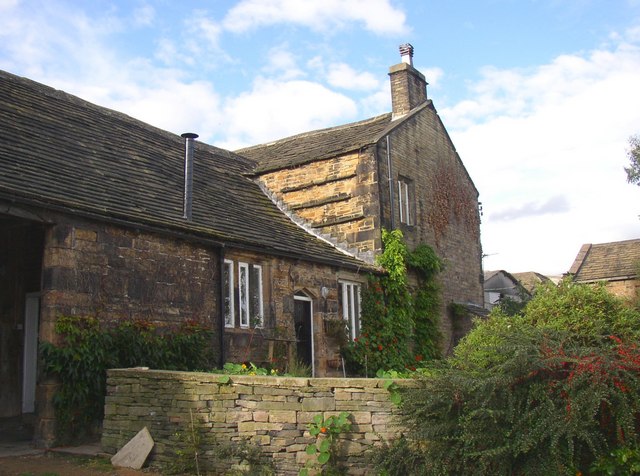Kirklees Priory near Clifton in West Yorkshire was a medieval nunnery associated with the legend of the death of Robin Hood. After the dissolution of the monasteries the site was sold to owners who demolished most of the priory and built Old Farm. Kirklees Hall postdates the priory. John Armytage, a clothier and merchant, acquired the property in 1565. Although little remains of the priory, Kirklees Park, which was owned by the Armytage family until 2013, contains many listed buildings, and the priory site is a scheduled monument.
Religious history
Kirklees Priory was a medieval Cistercian nunnery whose site was near Clifton in West Yorkshire. A priory dedicated to the Virgin Mary and St James was founded by Reiner le Fleming, Lord of the Manor of Wath upon Dearne in 1155 during the reign of Henry II.[1]
The Archbishop of York, William Greenfield, wrote to the prioress about rumours concerning the scandalous behaviour of Alice Raggid, Elizabeth Hopton, and Joan Heton between 1306 and 1315 that led to the house being considered one of disrepute.[1]
The priory is connected with the legend of Robin Hood. The outlaw is said to have fired an arrow from his deathbed in the priory’s gatehouse to select his burial place.[2]
The priory was not dissolved by the Dissolution of the Lesser Monasteries Act in 1535, but continued for worship and hospitality. Cecilia Topcliffe was the prioress. The convent consisted of the eight nuns who had been there on 4 February 1536 and who continued as before the passing of the Act. In 1539, after the Second Act of Dissolution, Joan Kyppes surrendered the priory, which had eight inmates. At the date of surrender the whole property was worth £29 18s. 9d.[1][3]
After the surrender, three nuns from the priory, Cecilia Topclife, Joan Leverthorpe and Katherine Grace, sought refuge at the priory guesthouse and ran it as a hostelry.[4] It became The Three Nuns inn. The present inn, now renamed, was built in 1939 and the site of the guest house is buried under the car park in front of the present building.[5]
Secular history
The priory was granted to John Tasburgh and Nicholas Savile who demolished the church and priory buildings and used the stone to build Low Hall which later became Home Farm. The farm complex includes late-medieval buildings that may have been part of the priory including two aisled barns which are now Grade I and II* listed and the gatehouse which is Grade II* listed. A walled garden is thought to have been the priory’s orchard.[3]
In 1565 the property was sold to John Armytage, a clothier and merchant. The Armytages spent large sum of money extending their estate their landholdings and the the stone mansion, presumably built for the previous owners in the mid 16th century. The mansion, now the Grade I listed Kirklees Hall, was developed between 1580 and 1640. The Armytages built the Jacobean north-facing range. Home Farm was also developed with the addition of a cross-wing dated 1620 to the medieval aisled barn closest to the gatehouse, the cow house and the two-cell house, which are both Grade II* listed. The architect John Carr altered and extended the hall in the 1760s, and designed an elaborate imperial staircase.[3]
The hall’s landscaped park and gardens were developed for Sir George Armytage the 3rd baronet in the late 18th century to the design of Richard Woods, and by Sir George Armytage the 6th baronet in the early 20th century.[3]
The sixth baronet, Sir George Armytage, conducted excavations in 1904 and 1905. He uncovered the plan of the priory church and cloisterCovered walkway usually set out in the form of a square.. He also excavated at Castle Hill in the parkland where he uncovered remains of rough stone walling and concluded that the site was a Roman fortification.[3] He built a Roman watchtower, now listed, in 1905, but the site is now thought to be an Iron Age defended farmstead or small settlement.[6]
In the early 1700s, the grave slab of Elizabeth de Stainton, the prioress of Kirklees sometimes wrongly identified as Robin Hood’s murderer, was discovered. It was mounted on a raised table tomb in a railed enclosure.[6] The reputed grave of Robin Hood is marked by an 18th-century grave stone enclosed by cast iron railings and inscribed in Chaucerian language. “Hear Underneath dis laitl stean Laz robert earl of Huntingtun Ne’er arcir ver az hie sa geud An pipl Kauld im robin heud Sick utlawz az hi an iz men Vil england nivr si agen Obiit 24 Kal Dekembris 1247”.[7][a]Here underneath this little stone Lays Robert Earl of Huntington, Never was an archer as he so good And people called him Robin Hood Such outlaws as he and his men Will England never see again
Notes
| a | Here underneath this little stone Lays Robert Earl of Huntington, Never was an archer as he so good And people called him Robin Hood Such outlaws as he and his men Will England never see again |
|---|



